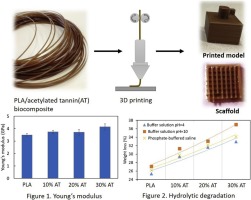Industrial Crops and Products ( IF 5.6 ) Pub Date : 2020-03-18 , DOI: 10.1016/j.indcrop.2020.112320 Jingjing Liao , Nicolas Brosse , Antonio Pizzi , Sandrine Hoppe , Xiaojian Zhou , Guanben Du

|
In this study, a three-dimensional (3D) printing filament prepared from poly (lactic acid) (PLA) and acetylated tannin via a twin-screw extruder was reported. The impact of acetylated tannin loading content on the final properties of the resulting composite materials and their 3D printability were investigated. The experimental results indicate that PLA can be compounded with up to 20 wt% acetylated tannin without any obvious deterioration in the tensile property. The resulting composites acquired better degradation rate in aquatic system compared with neat PLA, especially in alkaline medium. Moreover, all composites are printable and showed generally good printing quality with brown color, however, this is limited to temperatures reasonably below 220°C to avoid printing defects, especially at high loadings of acetylated tannin.
中文翻译:

聚乳酸/乙酰化单宁复合材料的表征和3D可印刷性
在这项研究中,报道了一种通过双螺杆挤出机由聚乳酸(PLA)和乙酰化单宁制成的三维(3D)印刷长丝。研究了乙酰化单宁酸含量对最终复合材料的最终性能及其3D可印刷性的影响。实验结果表明,PLA可以与最多20 wt%的乙酰化单宁配混,而拉伸性能没有任何明显的下降。与纯PLA相比,所得复合材料在水生系统中的降解率更高,尤其是在碱性介质中。而且,所有复合材料都是可印刷的,并且通常显示出褐色的良好印刷质量,然而,将其限制在合理低于220°C的温度下,以避免印刷缺陷,特别是在乙酰化单宁含量较高的情况下。











































 京公网安备 11010802027423号
京公网安备 11010802027423号